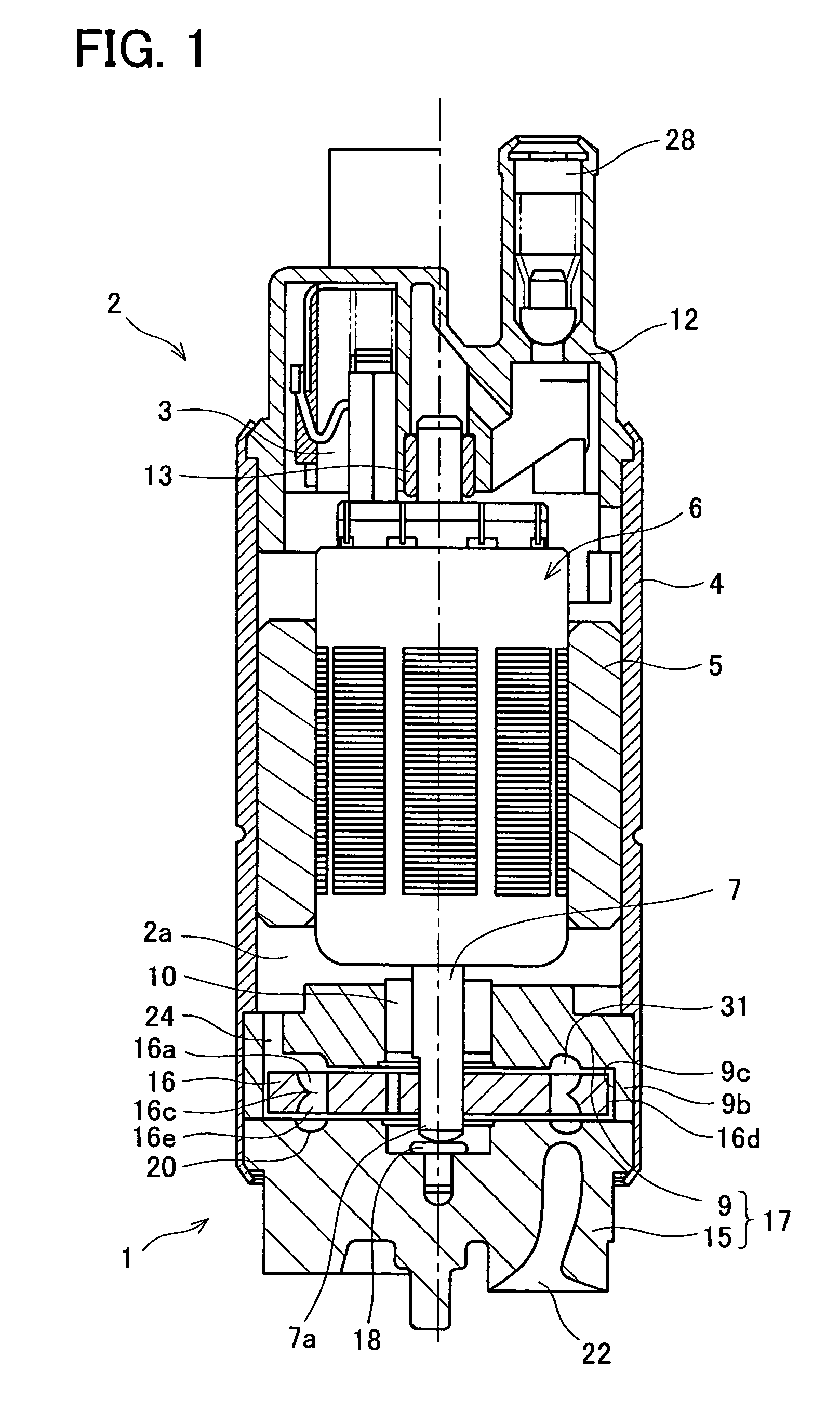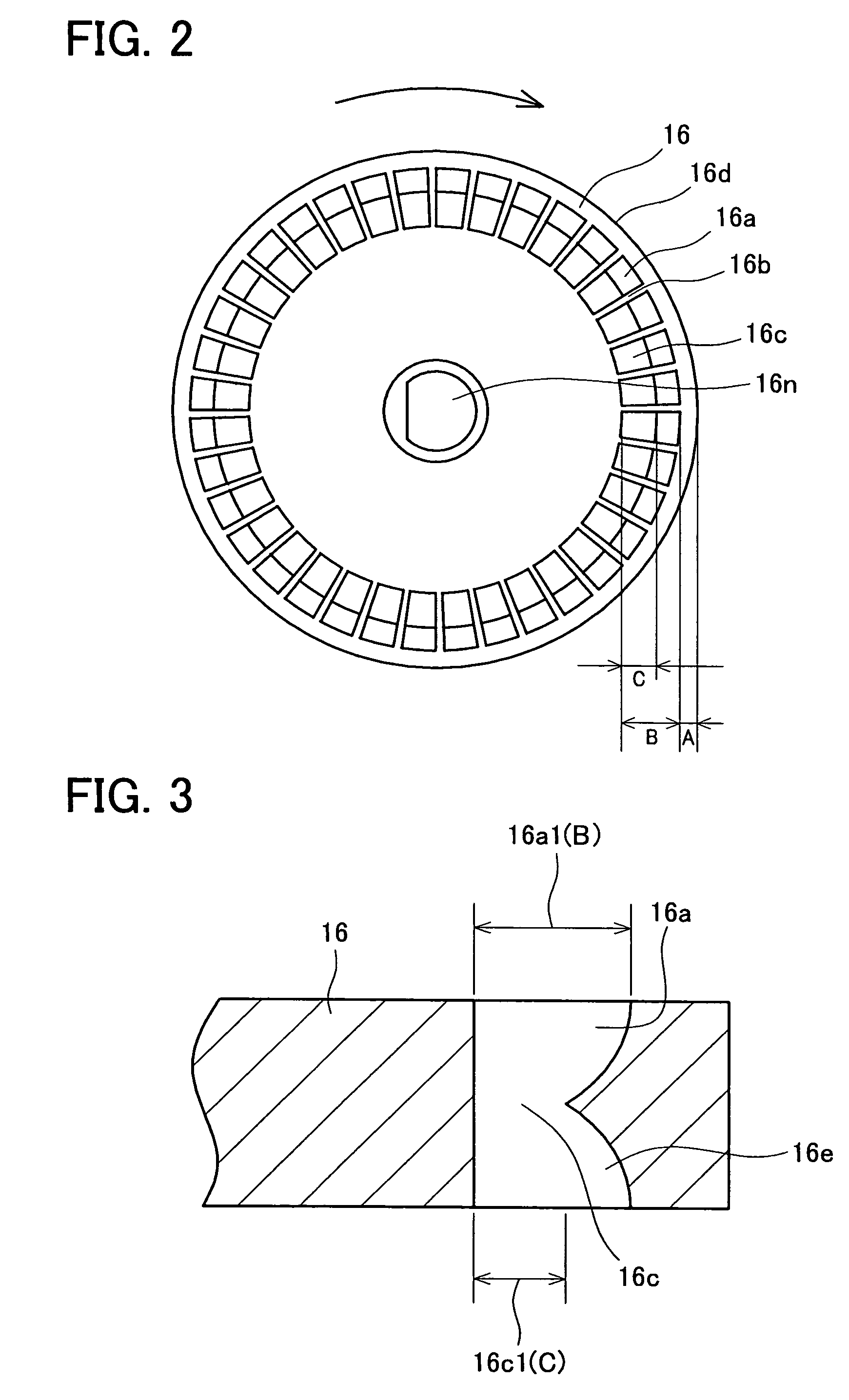Fuel pump
a fuel pump and pump body technology, applied in the direction of positive displacement liquid engine, piston pump, liquid fuel engine, etc., can solve the problems of easy vaporization of fuel that has been drawn into the casing, decreased pressurizing force of the fuel pump, and insufficient quantity of fuel discharged from the pump
- Summary
- Abstract
- Description
- Claims
- Application Information
AI Technical Summary
Benefits of technology
Problems solved by technology
Method used
Image
Examples
first embodiment
[0044]the present invention is described referring to FIGS. 1 to 5. FIG. 1 shows a cross-sectional view of the fuel pump of the present embodiment, FIG. 2 shows a plane view of an upper face of an impeller of this fuel pump, FIG. 3 shows a cross-sectional view showing peripheral portion of the impeller, and FIG. 4 shows a cross-sectional view showing essential part of the fuel pump. Further, components that are identical in the conventional fuel pump and in the present embodiment have the same reference numbers assigned thereto.
[0045]The fuel pump of the present embodiment is used in a motor vehicle, the fuel pump being utilized within a fuel tank and being utilized for supplying fuel to the engine of the motor vehicle. As shown in FIG. 1, the fuel pump is composed of a pump section 1 and a motor section 2 for driving the pump section 1. The motor section 2 is provided with a brush 3, a magnet 5 located within an approximately cylindrical housing 4, and a rotating member 6 concentri...
second embodiment
[0064]FIG. 6 shows an enlarged cross sectional view of the impeller in the A group of concavities 66a is formed in an upper face of the impeller 66, and a group of concavities 66e is formed in an lower face of the impeller 66 as shown in FIG. 6. Bottom portions of the pair of upper concavities 66a and lower concavities 66e communicate via through-holes 66c. Each of the through-holes 66c is formed within a region at the inner side of each of concavities 66a, 66e. The bottom portions of the upper and lower concavities 66a, 66e are separated by a partitioning member 66h. The partitioning member 66h is formed from a wall 66g1 at the outer side of the upper concavity 66a and a wall 66g2 at the outer side of the lower concavity 16e, and is formed at a central portion of the impeller 66 relative to the direction of thickness thereof. The wall faces 66g1 and 66g2 located at the outer side of the concavities 66a, 66e are curved, and extend towards the bottom portions to make contact with a ...
third embodiment
[0068]FIG. 7 shows an enlarged cross sectional view of an impeller of the A groups of concavities 76a is formed in an upper face of an impeller 76 and a groups of concavities 76e is formed in an lower as shown in FIG. 7. Bottom portions of the pair of upper and lower concavities 76a, 76e communicate via a through-hole 76c. Each of the through-holes 76c is formed at the inner side of each of the concavities 76a, 76e. The bottom portions of the upper and lower concavities 76a, 76e are partitioned by a partitioning member 76h.
[0069]Inclined faces 76j are formed at the inner sides of the upper and lower concavities 76a, 76e formed in the impeller 76. These inclined faces 76j are inclined outwardly in the radial direction towards the bottom. The impeller 76 of the fuel pump of the present embodiment differs in this point from the impeller 66 of the fuel pump of the second embodiment.
[0070]The impeller 76 is formed by a resin which is molded within a molding die and extracted from the d...
PUM
 Login to View More
Login to View More Abstract
Description
Claims
Application Information
 Login to View More
Login to View More - R&D
- Intellectual Property
- Life Sciences
- Materials
- Tech Scout
- Unparalleled Data Quality
- Higher Quality Content
- 60% Fewer Hallucinations
Browse by: Latest US Patents, China's latest patents, Technical Efficacy Thesaurus, Application Domain, Technology Topic, Popular Technical Reports.
© 2025 PatSnap. All rights reserved.Legal|Privacy policy|Modern Slavery Act Transparency Statement|Sitemap|About US| Contact US: help@patsnap.com



